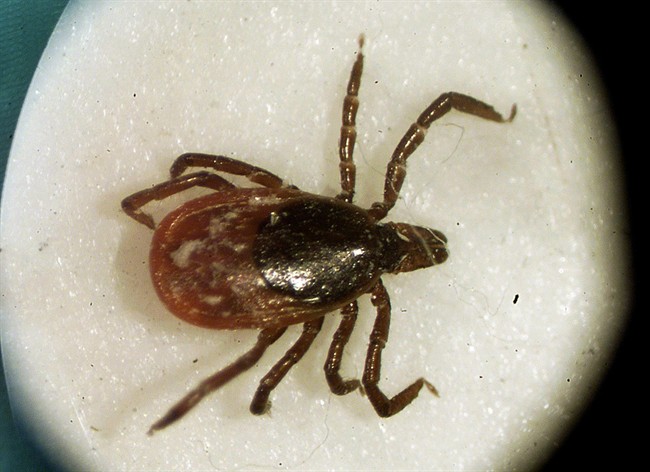Some NDG residents are concerned about ticks in the borough, but Montreal Public Health says ticks are not a big problem in the city.

One in five of the parasites can transmit Lyme disease.
Last week Global News brought you the story of an NDG mother who had noticed a bull’s-eye rash on her toddler, a telltale sign of a tick bite.
Doctors couldn’t confirm that’s what it was, but she thought he was bitten at Loyola Park.
READ MORE: NDG parent wants Montreal to take action on ticks
“They wouldn’t be able to confirm 100 per cent because I didn’t have the tick. It was inconclusive,” Sandrine Campeau told Global News.
Cases of Lyme disease in Quebec have increased six fold in the past five years. There were 32 five years ago, compared to 180 last year.
“Lyme disease has been progressing in Quebec in the last several years. In Montreal it’s been fairly stable, about 25 cases per year,” said Dr. Paul Le Guerrier, a physician with Montreal Public Health.
He couldn’t say whether the increase in cases in the province will lead to more Lyme disease diagnoses in Montreal
“We’re not quite sure but we are expecting an increase in cases on the South Shore,” said Le Guerruer.
He told Global News the tick problem is far more severe on the South Shore and the Eastern Townships, but said areas on the island with thick woods or grass could have them too.
“Ticks are part of nature so it’s going to be kind of difficult to get rid of them from the Island of Montreal. I think clearing parks and making sure that there are not tall grasses, that there are safe trails and safe places for kids to play is a really good idea. I think the city should take those works,” he said.
The NDG borough told Global News they have no specific plans to combat ticks at this time, and hadn’t had any complaints.
Dr. Le Guerrier recommends wearing sleeves, pants and light-coloured clothing if going into the woods, and to make sure ticks aren’t on your body afterward.
READ MORE: Experts warn Lyme disease on the rise in Quebec
“Check your whole body, you can also remove your clothes and put them in the dryer for ten minutes. Check your dog as well,” he said.
Le Guerrier also recommends bug spray with DEET in it to keep the ticks off.
Symptoms of Lyme disease include fever, headache, muscle and joint pain, and usually a bull’s-eye rash.
Le Guerrier says to go to a doctor immediately if you suspect Lyme disease.
“Most people who receive treatment fully recover,” he said.
Though he says Lyme disease is nowhere near as serious a problem here as it is in the Northeastern U.S., he concedes it’s not going anywhere.
“Lyme disease is going to be here to stay.”


Comments